How we use Car Cards on the QUAKER VALLEY
RAILROAD
This page describes the use of the Card Cards and
Waybills on our home road.
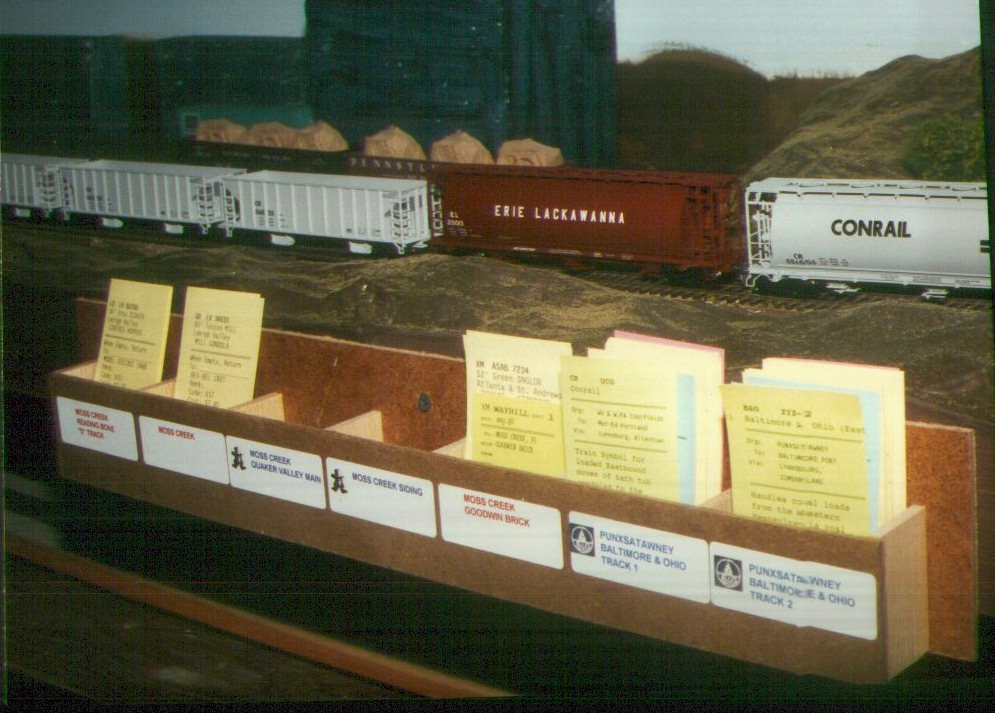 On
the Quaker Valley, each town and yard location has a slot for each
track or industry. We do not use the Setout/Hold/Pickup rules
for car cards and waybills. The car cards for the cars located on
the railroad are stored in the appropriate slot. I have
assembled these from pine lattice boards and masonite. The
1-1/4” pine lattice provides a uniform size for the sides and
bottom of the card box. Masonite panels are glued on front and
rear. I use drywall screws to attach these multiple slot boxes
to the railroad fascia. Labels identify each industry or yard
track. What you see pictured here is the town of Moss Creek.
Industry tracks (in red) are for Reading Bone Fertilizer, Cyphert
Machine and Goodwin Brick. The two tracks identified with the
QV logo are the mainline and a passing siding. The two track
boxes to the right are for B&O staging tracks which join the QV
mainline just east of Moss Creek at Twin Rocks.
On
the Quaker Valley, each town and yard location has a slot for each
track or industry. We do not use the Setout/Hold/Pickup rules
for car cards and waybills. The car cards for the cars located on
the railroad are stored in the appropriate slot. I have
assembled these from pine lattice boards and masonite. The
1-1/4” pine lattice provides a uniform size for the sides and
bottom of the card box. Masonite panels are glued on front and
rear. I use drywall screws to attach these multiple slot boxes
to the railroad fascia. Labels identify each industry or yard
track. What you see pictured here is the town of Moss Creek.
Industry tracks (in red) are for Reading Bone Fertilizer, Cyphert
Machine and Goodwin Brick. The two tracks identified with the
QV logo are the mainline and a passing siding. The two track
boxes to the right are for B&O staging tracks which join the QV
mainline just east of Moss Creek at Twin Rocks.
Some
folks try to make using car cards and waybills much more difficult
than it really is. The waybill in the car card box tells you where
the car should be when you are done working that track, station, yard
or industry. If the car isn't where it is supposed to be; move it to
or towards the desired location indicated on the waybill. Crews do
not change the waybill during an operating session. They just "read
and heed" as a real railroader would do when looking at an
actual waybill.
Crew
Process:
When
picking up a train in staging or at a yard, the crew will check the
car cards against the train and make sure they have all cards and
are in order. A count of cars should be noted.
When
a local crew enters a town for switching, they check all track bill
boxes to see what cars are ready to be picked up. If a bill reads TO
the town they're in, obviously it's not ready to be picked up yet.
So a car dropped off a few minutes ago still says TO this town, and
the bill is put back in the box.
If
the bill reads TO another location, then obviously the car is to be
picked up. Thus one bill box does the work of the three bill boxes
in the old scheme.
Since
there is a bill box for EVERY track in town, if a car cannot be
spotted because that spot is occupied by a car not ready to be
picked up yet, the car is left “off spot” on a storage track or
another open industry track. The car card/waybill is put in that
track's box. The next local crew working that town will come across
that bill and car and spot it if the spot has since been cleared.
Car
cards from the local train that are set out are placed in the
appropriate industry box as the set outs are made.
Car
cards for the pickups are placed in the pack for the local train in
the same order as the cars in the train.
When
a train enters a yard, the yardmaster will exchange with the crew
all cars and car cards that match.
When
a train terminates in staging, the crew will place the car cards in
the appropriate staging track box backwards to indicate the train
has run that session.
Agent
Process:
Between
sessions, the way bills are cycled by the layout owner. Waybills for
cars that are located at their destination “TO entry” industry
MAY be cycled for their next destination on the 2 or 4 sided
waybill. Some waybills are removed revealing the “When Empty
Return To xxx” instruction on the car card. I often will
purposely leave a car at the industry for an extra session and have
the rear car ready to pickup to generate additional switching by the
next local crew.
Waybills
and car cards for cars that are “off spot” are left alone.
My
industry at Goodwin Brick generates request(s) for empty boxcars
from the Lynnsburg yard. There is a stack of waybills in the box at
Moss Creek for this industry. When restaging, I randomly select 0,
1 or 2 waybills and place them at Lynnsburg yard. The yardmaster
needs to find suitable empty box cars and send them to Moss Creek on
the next Costello Turn.
Car
cards for equipment that reaches the Costello yard (the furthest
north modeled area) which are destined for Buffalo and Rochester
will also be cycled. Waybills still to be delivered locally are left
alone.
Trains
in staging are usually run out into the open and waybills are
cycled. I have many cars that remain on the train and never are
switched out. The waybills for these cars may have 4 eastbound
sources and 4 westbound destinations, and even though they are
different, stay in that train. Waybills for cars that were picked
up are cycled and the cars may be physically moved in the train to
block the setouts for the Lynnsburg yard at the front for Eastbound
trains and at the rear for Westbound trains. I insert a separator
card to indicate the setout pint in the pack of car cards.
Through
hopper trains on the double ended Conrail staging tracks may simply
have the car card/waybill pack turned around in the box to be ready
for the next session. This keeps empties moving west and coal
moving east.
Trains
headed into stub end staging are usually just run backwards between
sessions to return them to their starting point for the next
session. Cars may be physically moved between trains or back to the
yards to create some variety. For trains like the ore train, this
precludes the need to load and unload individual open cars.
Using
the four-cycle waybill may therefore require five or six sessions to
cycle back to the original bill. By then, no one will remember that a
particular car was spotted at a specific place, so there is no need
to ever remove a waybill from its card card for the sake of variety.
I also use quite a few 2 sided waybills to run a car or group of cars
back and forth between two locations. This is very prototypical.
WAYBILL and TRAIN
CARD FORMATS from the Waybill Program
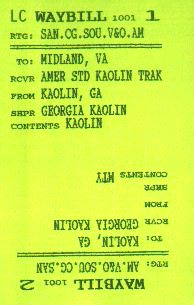
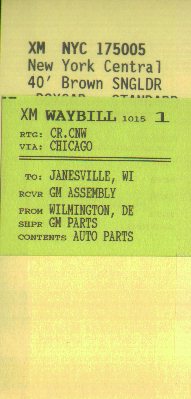
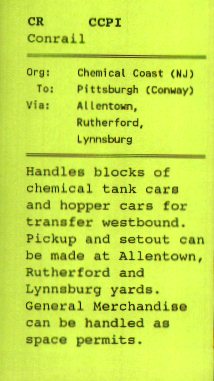
We have printed our own waybills using our own program, but these
can be reproduced with any spreadsheet today. We use 2, 3 and 4
sided waybill forms. The form above shows side 1 and 2 and the
card
is flipped for sides 3 and 4. The waybills are inserted into a
pocket
on the car card formed by folding up the lower 1.5" and taping the
sides
together. Between operating sessions, the waybills are flipped to
show the next car destination. Our Waybill program also prints a
Train Card to describe the work accomplished during an operating
session.
CAR CARD FORMATS
from
the Roster Program

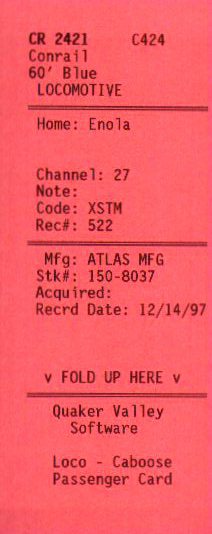
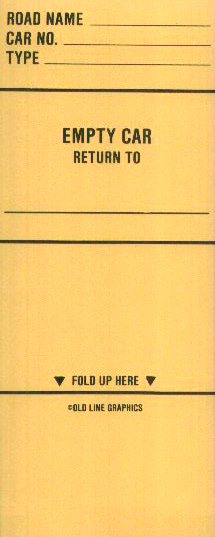
Our Roster program includes a channel
number for DCC or Command Control locomotives. It also has a revised
format for the Car Card and Loco Card which eliminates the unit cost and
other model related information. Only the data required for operations
appears on the card. These cards are compatible with those from Old Line
Graphics as shown.
Web page modifed 10/5/2013
 Return to Quaker Valley home page
Return to Quaker Valley home page
 On
the Quaker Valley, each town and yard location has a slot for each
track or industry. We do not use the Setout/Hold/Pickup rules
for car cards and waybills. The car cards for the cars located on
the railroad are stored in the appropriate slot. I have
assembled these from pine lattice boards and masonite. The
1-1/4” pine lattice provides a uniform size for the sides and
bottom of the card box. Masonite panels are glued on front and
rear. I use drywall screws to attach these multiple slot boxes
to the railroad fascia. Labels identify each industry or yard
track. What you see pictured here is the town of Moss Creek.
Industry tracks (in red) are for Reading Bone Fertilizer, Cyphert
Machine and Goodwin Brick. The two tracks identified with the
QV logo are the mainline and a passing siding. The two track
boxes to the right are for B&O staging tracks which join the QV
mainline just east of Moss Creek at Twin Rocks.
On
the Quaker Valley, each town and yard location has a slot for each
track or industry. We do not use the Setout/Hold/Pickup rules
for car cards and waybills. The car cards for the cars located on
the railroad are stored in the appropriate slot. I have
assembled these from pine lattice boards and masonite. The
1-1/4” pine lattice provides a uniform size for the sides and
bottom of the card box. Masonite panels are glued on front and
rear. I use drywall screws to attach these multiple slot boxes
to the railroad fascia. Labels identify each industry or yard
track. What you see pictured here is the town of Moss Creek.
Industry tracks (in red) are for Reading Bone Fertilizer, Cyphert
Machine and Goodwin Brick. The two tracks identified with the
QV logo are the mainline and a passing siding. The two track
boxes to the right are for B&O staging tracks which join the QV
mainline just east of Moss Creek at Twin Rocks.






